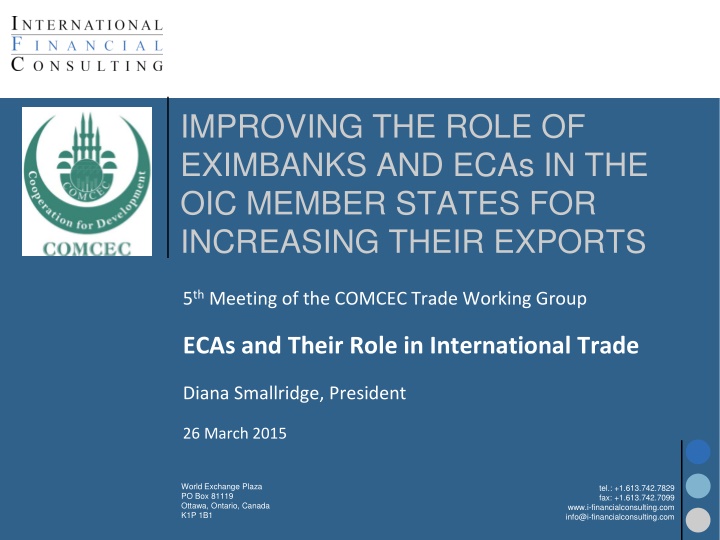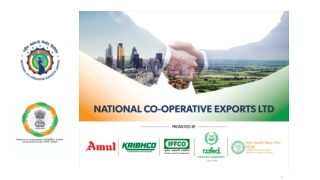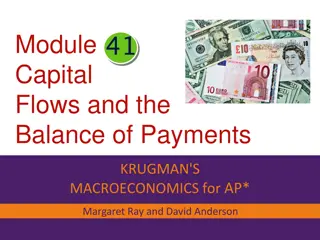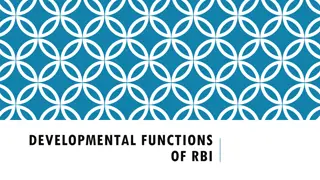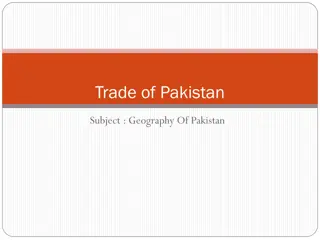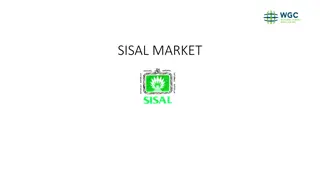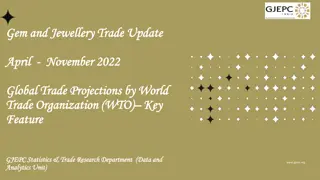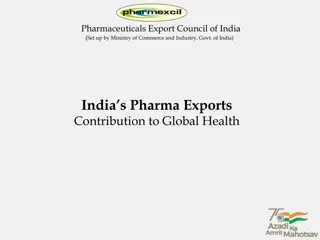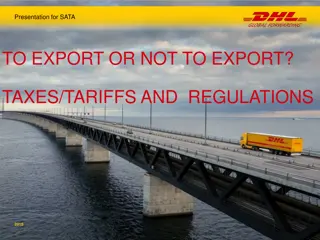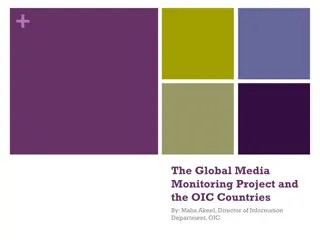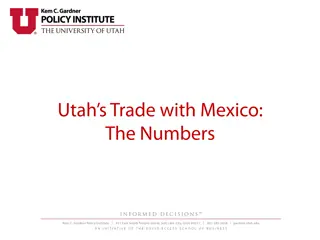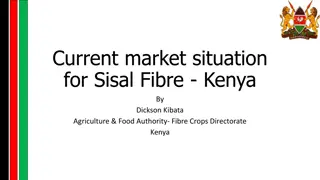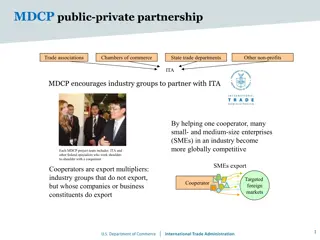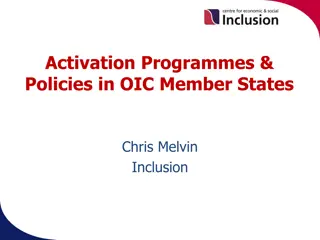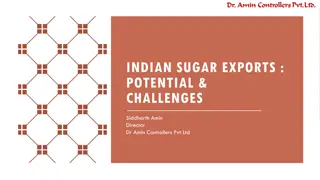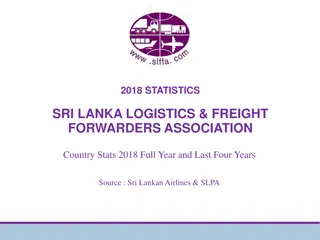Enhancing Exports Through OIC ECAs
This content explores the role of Export Credit Agencies (ECAs) in OIC member states to boost exports by supporting international trade transactions. It covers the functions, features, and best practices of ECAs, along with recommendations for improving their effectiveness in increasing exports.
Download Presentation

Please find below an Image/Link to download the presentation.
The content on the website is provided AS IS for your information and personal use only. It may not be sold, licensed, or shared on other websites without obtaining consent from the author.If you encounter any issues during the download, it is possible that the publisher has removed the file from their server.
You are allowed to download the files provided on this website for personal or commercial use, subject to the condition that they are used lawfully. All files are the property of their respective owners.
The content on the website is provided AS IS for your information and personal use only. It may not be sold, licensed, or shared on other websites without obtaining consent from the author.
E N D
Presentation Transcript
IMPROVING THE ROLE OF EXIMBANKS AND ECAs IN THE OIC MEMBER STATES FOR INCREASING THEIR EXPORTS 5thMeeting of the COMCEC Trade Working Group ECAs and Their Role in International Trade Diana Smallridge, President 26 March 2015 World Exchange Plaza PO Box 81119 Ottawa, Ontario, Canada K1P 1B1 tel.: +1.613.742.7829 fax: +1.613.742.7099 www.i-financialconsulting.com info@i-financialconsulting.com
Introduction ECAs in a general context ECA facilities and features ECAs in OIC countries Features of ECAs in OIC countries Best practices of ECAs Recommendations and Conclusions 1. 2. 3. 4. 5. 6. 2
There are different kinds of institutions that can be called Export Credit Agencies Export Credit Insurance Agencies (ECIAs) insure commercial or political risks in countries to where their companies are exporting. Export-Import Banks (Eximbanks) provide lending and other facilities in support of exports, either directly to exporters or to foreign buyers to purchase national goods and services. Export Development Banks are specialized development banks that are focused on international trade and investment and are similar to Eximbanks in terms of facilities offered. 4
Their mandates are the same but facilities can be different The common ECA mandate is to support and encourage exports and outward investment by providing financial services in support of international trade and investment transactions Types of ECA facilities: Financing directly to exporters and buyers Financing indirectly through guarantees issued to commercial banks who lend to exporters Credit insurance to exporters and banks Support to importers to facilitate their payment obligations to exporters 5
ECAs are established to serve two main purposes To diversify a country s export base and export markets By taking risks on new buyers, in new markets for new exporters By financing exporters and export transactions 1. To fill market gaps and address market disruptions By identifying parts of the market that the private sector course of finance and insurance are unable to address, such as SMEs, or foreign buyer risks 2. 6
OIC ECAs contributions to trade are relatively low Total Exports (USD bn) 2009 2010 2011 2012 2013 World 16,092.07 18,032.63 19,147.48 19,726.98 20,357.48 OIC Countries 1,329.35 1,680.77 2,122.48 2,261.77 2,215.79 Total Business Volumes (USD bn) 2009 2010 2011 2012 2013 Berne Union 1,314 1,689 1,686 1,721 1,801 OIC ECAs (Aman Union) 21.9 OIC ECAs/OIC exports <1% 7
Competition is not between ECAs per se but between exporters Competition between exporters must be on price and quality of exporter product and service, rather than on the price of their financing Subsidized financing packages can create an unleveled playing field Two agreements reflect this understanding: The WTO and the OECD Arrangement on Export Credits The OECD Arrangement and the safe haven 8
ECAs benefit from bilaterally and multilateral cooperation Strategic Co-operation Berne Union, Prague Club, Aman Union, G- NEXID, Asian EXIM Banks Forum, COFACE Partner Network Transactional Co-operation Debt collection and buyer information Reinsurance/coinsurance on multi-sourced transactions 9
ECA FACILITIES AND FEATURES 10
ECA provide facilities along the Export Chain 11
There are five main types of facilities offered Financing facilities Short-, medium- and long-term domestic and foreign loans Guarantee facilities Domestic and foreign risks Insurance facilities Credit insurance and investment insurance Bonding facilities Support for both wrongful and rightful calls Advisory and other services Overseas market information, country/buyer risk assessment, general export-readiness guidelines for SMEs, consultancy services, buyer credit information on their local companies to other credit insurers 1. 2. 3. 4. 5. 12
23 of 57 OIC Member States have ECAs, EXIMS or programs Country Nigeria Senegal Algeria Bahrain Egypt Entity Providing Facilities Nigerian Export-Import Bank (NEXIM) Societe Nationale d Assurance du Credit et du Cautionnement (SONAC) Compagnie Alg rienne Assurance et de Garantie des Exportations (CAGEX) Export Credit Guarantee Programme under Bahrain Development Bank Export Development Bank of Egypt (EDBE) Export Credit Guarantee Company of Egypt (ECGE) Jordan Loan Guarantee Corporation (JLGC) The Lebanese Credit Insurer (LCI) Soci t Marocaine d'Assurance l'Exportation Export Credit Guarantee Agency of Oman (ECGA) Qatar Export Development Agency (TASDEER/QDB) Saudi Export Program (SEP) under the Saudi Fund for Development (SFD) National Agency for Insurance and Finance of Exports (NAIFE) Compagnie Tunisienne pour l'assurance du commerce ext rieur (COTUNACE) Export Credit Insurance Company of the Emirates (ECIE) Export Credit Guarantee Fund under Albania Investment Development Agency (AIDA) Sadharan Bima Corporation's Export Credit Guarantee Department (ECGD) Asuransi Ekspor Indonesia (ASEI) Indonesia Eximbank Export Development Bank of Iran Export Guarantee Fund of Iran (EGFI) Export Credit Insurance Corporation (KazExportGarant) EXIM Bank of Malaysia (MEXIM) Pakistan Export Finance Guarantee Agency Ltd Export Credit Bank of Turkey (Turk EXIM bank) National Export-Import Insurance Company (UZBEKINVEST) Jordan Lebanon Morocco Oman Qatar Saudi Arabia Sudan Tunisia United Arab Emirates Albania Bangladesh Indonesia Iran Kazakhstan Malaysia Pakistan Turkey Uzbekistan 14
More than 50% of OIC Member Countries do not have ECAs There may a range of reasons why: There may not be a need for ECA facilities or there is lack of demand. The needs of exporters are being met by other national entities. There are needs, but there is lack of awareness on the part of exporters, banks and the government. There is lack of financial resources from the government to set up a new institution/facility. There may have been an ECA facility in place in the past, but it expired or failed. 1. 2. 3. 4. 5. 15
FEATURES OF ECAs IN OIC COUNTRIES 16
There is no single perfect model for an ECA ECA objectives vary based on unique country context ECA effectiveness cannot be measured only by its operational and financial success Rather, what is important is whether the needs of all stakeholders involved are being met Exporters Government Private sector providers of lending and insurance 17
In#general,#a#healthy#system#is#one#that#effectively#balances#various#stakeholder#needs#and#In#general,#a#healthy#system#is#one#that#effectively#balances#various#stakeholder#needs#and# interests,#while#accomplishing#the#ultimate#goal# #providing#exporters#with#the#support#they# need# to# be# internationally# competitive.# # # # Figure'1:'A'Healthy'Export'Credit'System' ' There is however a Healthy Export Credit System . Export Credit System Health Parameters Government has sufficient control, relative to its involvement in the export credit system Government sets clear and attainable objectives System is regularly reviewed to reflect changes in the private sector Fiscal costs are measured and minimized Government Control & Oversight Exporters get the coverage they need in the markets they are doing business The product range meets the needs of exporters and their banks Pricing is risk-related and internationally competitive ECA is proactive and demonstrates innovation and flexibility Exporter Focus/ Service Mission Statement and Strategic Objectives The institution s expertise is well-recognized and sought after The portfolio is actively managed The internal processes are not bureaucratic The institution s human resources are stable and decisions are consistent Institutional Strength ECA works well with banks ECA works well with insurers ECA actively encourages participation of private players There is no displacing/impeding of the private sector Private Sector Involvement # # 18 2.1.1Government# Control# and# Oversight# For#Government#Control#and#Oversight,#the#question#that#is#considered#is#the#extent#to#which# the#government#both#has#the#appropriate#level#of#control#relative#to#its#involvement#and#is# providing# the# ECA# with# the# necessary# guidance# to# ensure# that# public# policy# objectives# are# being# met.#Moreover,#this#area#looks#at#whether#there#are#controls# #adequate#or#otherwise# #over# the# fiscal# costs# of# providing# export# credit# support.# # The# key# dimensions# of# health# for# this# dimension# are:# # #
OIC ECAs vary by age 1978 Sadharan Bima Corporation's Export Credit Guarantee Department (ECGD) - Bangladesh 1984 Compagnie Tunisienne pour l'assurance du commerce ext rieur (COTUNACE) - Tunisia Asuransi Ekspor Indonesia (ASEI) - Indonesia Export Development Bank of Egypt (EDBE) 1985 1987 Export Credit Bank of Turkey (Turk EXIM bank) - Turkey Export Credit Guarantee Agency of Oman (ECGA) - Oman Nigerian Export-Import Bank (NEXIM) - Nigeria Export Development Bank - Iran 1991 Soci t Marocaine d'Assurance l'Exportation - Morocco Export Credit Guarantee Company of Egypt (ECGE) - Egypt 1992 Jordan Loan Guarantee Corporation (JLGC) - Jordan National Export-Import Insurance Company (UZBEKINVEST) - Uzbekistan Export Guarantee Fund of Iran (EGFI) - Iran 1994 1995 EXIM Bank of Malaysia (MEXIM) - Malaysia 1996 Compagnie Alg rienne Assurance et de Garantie des Exportations (CAGEX) - Algeria 1997 National Co. for Credit Insurance and Guarantee (SONAC) - Senegal 1999 Saudi Export Program (SEP) under the Saudi Fund for Development (SFD) 2000 Pakistan Export Finance Guarantee Agency Ltd - Pakistan 2001 The Lebanese Credit Insurer (LCI) - Lebanon 2003 Export Credit Insurance Corporation (KazExportGarant) - Kazakhstan National Agency for Insurance and Finance of Exports (NAIFE) - Sudan 2005 Credit Guarantee Fund under Albania Investment Development Export Agency (AIDA) - Albania 2007 2008 Export Credit Insurance Company of the Emirates (ECIE) United Arab Emirates 2009 Indonesia Eximbank 19 Export Credit Guarantee Programme under Bahrain Development Bank - Bahrain Qatar Export Development Agency (TASDEER/QDB) - Qatar 2011
OIC ECAs mandates vary based on export development strategies Diversify into non-oil sectors (Oman, Qatar, Iran and Saudi Arabia) Increase national exports and promote new trade relations (Algeria, Jordan, Lebanon, Nigeria and Senegal) Grow exports in specific sectors such coffee, rubber and manufacturing (Indonesia, Kazakhstan, Turkey and Malaysia) Support SMEs as instruments for export growth (Pakistan and Albania) 20
OIC ECAs share some common operating principles Non-competition with private sector sources of finance and insurance Maximum response times to clients 21
OIC ECAs have varying corporate forms Bahrain, Qatar Saudi Arabia Albania ` Other 15% Nigeria, Oman, UAE, Bangladesh, Indonesia, Iran, Kazakhstan, Malaysia, Turkey and Uzbekistan Lebanon Privately-owned 4% State-owned 46% Senegal Algeria Morocco Tunisia Sudan Pakistan Mixed state/private ownership (majority private sector) 23% Mixed state/private ownership (majority public sector) 12% Egypt, Jordan 22
OIC ECAs have 3 levels of touchpoints with Government Financial Governance Policy 23
Governments financial support for an ECA can take different forms One-time or multiple capital injections Fund, guarantee, reinsure transactions Facilitate borrowing of an ECA by lending to it Serve as a backer/guarantor of ECA borrowings 24
Government participation in governance is determined by level of ownership Based on shareholding status, government is allotted a certain number of representatives on ECA Boards Nature of participation includes general governance and, in some instances, management of the entity 25
As an instrument of public policy, the government s influence varies There is a spectrum of policy influence exercised by governments over their ECAs Adoption of government policy Influenced by government policy Independent of government policy Weak Relationship Strong Relationship ECA s direct adoption of government policy as an institutional mandate signals a strong relationship between the two. 26
OIC ECAs have adopted various business models Oman Senegal Morocco Tunisia Algeria Jordan Kazakhstan UAE Qatar Bangladesh Indonesia (ASEI) The model based on the unique national needs and circumstances Insurance Only ECA Full-service ECA Turkey Indonesia (Exim), Saudi Arabia, Sudan, Nigeria Lending only ECA Egypt Iran 27
OIC ECAs offer 6 types of facilities and products Financing facilities Guarantee facilities Insurance facilities Bonding facilities Islamic finance and insurance instruments Advisory or other services 28
Facilities cater to exporters needs across the Export Chain 29
OIC ECAs offering various kinds of Financing products Financing Facilities ECA in OIC Member Country Foreign input facility and local current facility Nigeria, Turkey, Indonesia (Exim) Financing for purchase of raw materials and inputs Nigeria, Indonesia (Exim) Sudan Special facilities financing for SME exporters Turkey Classic trade finance products Nigeria, Indonesia (Exim), Iran (EBDI), Turkey Receivable finance from existing export sales Nigeria Factoring or receivables discounting Egypt (ECGE), Lebanon Upstream financing for future exports/exporters NIgeria Saudi Arabia, Malaysia, Turkey, Indonesia (Exim), Iran (EBDI) Classic buyer s credit facilities to overseas buyers of their country s exports Project finance facilities Turkey, Malaysia 30
OIC ECAs offer two main kinds of Guarantee facilities to banks Domestic credit guarantees International guarantees to foreign/local banks NEXIM JLGC SEP NAIFE ECGF Indonesia EXIM EDBI MEXIM PEFG Turk EXIM MEXIM Turk EXIM SEP Indonesia EXIM EDBI 31
Almost all OIC ECAs offer Insurance facilities All but Uzbekinvest, EDBE, Albania and EDBI offer export credit insurance Whole turnover basis Insurance on domestic sales (Senegal, Egypt (ECGE), Jordan, LCI, Oman) Special transaction basis Credit insurance to cover documentary credits for banks (Saudi Arabia, Kazakhstan, Malaysia) A few offer foreign investment insurance (Indonesia, Kazakhstan, Malaysia) 32
OIC ECAs offer two types of bonding facilities These facilities are offered by ECAs Senegal, Algeria, Bahrain, Iran, Malaysia, Turkey and Uzbekistan Insurance against unfair or wrongful calling of bonds (covers political risks) Guarantees against any calling of the bond, wrongful or rightful Bonding Facilities 33
A small number of OIC ECAs offer Islamic finance and insurance instruments Shariah- compliant general insurance Indonesia Islamic versions of conventional financing Indonesia (Exim) Malaysia Shariah- compliant credit insurance Qatar Malaysia Islamic Finance and Insurance Facilities 34
Data on Business Volumes supported by OIC ECAs has limitations Data is available for only 18 institutions About a third of these institutions do not have updated data Inconsistencies in the type of data reported (some entities in the Aman Union report lending numbers while others include domestic credit insurance in their data) 35
Business Volume of OIC ECAs varies significantly Distribution of OIC ECAs by Business Volume (USD Millions) 8 7 6 5 4 3 2 1 0 < $100m $100 - $500m $500 - $1,000m $1,000 - $2,000m $2,000 - $3,000m > $3,000 m 36
ECAs BV/Exports indicates its importance to the national economy This share of exports indicates the level of ECA involvement in supporting exports 37
OIC ECAs average BV/Exports appears consistent with OECD ECAs but is actually much lower Average business volumes to exports for OIC ECAs is 5.48% Note: OIC Average falls to 1.84% when excluding Turk Exim and LCI Distribution of OIC ECAs by Business Volume as % of Exports (%) 8 7 6 5 4 3 2 1 0 < 1% 1 - 5% 5 - 10% > 10% 38
OIC ECAs partner with various private and public sector entities Internat l Banks Private Insurers Domestic banks National ECA National dev t banks Other ECAs Gov t agencies Assoc ns 39
Eight case studies of OIC and Non-OIC ECAs are showcased OIC Nigeria Malaysia Turkey Indonesia Lebanon 1. 2. 3. 4. 5. Non-OIC New Zealand Finland Canada 1. 2. 3. 41
Nigeria: Sharp focus on specific SME export market NEXIM focuses on non-oil exports and virgin segments of the market which commercial banks are not structured to service Lessons learned: Identify comparative advantage and build knowledge Establish a clear vision and mission to define a market space in which to focus Ensure good, up-to-date and reliable product information is available 42
Malaysia: Linking local businesses to global markets with a full product offering MEXIM supports export oriented businesses, especially those in non-traditional sector, in their expansion to new regional and global markets Lessons learned: Have a defined mandate, design niche products and invest in staff Establish a Client Charter Form smart partnerships 43
Turkey: ECA with government back-stop Loss incurred under TurkExim s programs due to political risks are covered by the Turkish Treasury and compensated appropriately Lessons learned: Nature of government support Partnerships to benefit clients By participating in international groups, monitor and follow other ECAs to diversify its products and to develop new ones with an innovative approach 44
Indonesia: A flexible business model for today s markets Indonesia s twin ECAs both offer Shariah- compliant products Lessons learned: Give the ECA a clear mandate Flexible business model and innovative new products for new/existing clientele Strong government backing Sound underwriting processes 45
Lebanon: Export credit services delivered exclusively by the private sector Lebanon s LCI is the only entity addressing the export market and supports SMEs in engaging in domestic and cross-border trade Lessons learned: Private sector has significant capacity to insure exports but cannot meet all the needs Holistic support to clients 46
New Zealand: The pragmatic go-slow approach New Zealand s NZECO adopted a slow and careful approach in identifying and addressing the needs of exporters and relied on outsourcing its technical management Lessons learned: Start slow Listen to the exporters Outsource to the experts Create synergies with other parts of government 47
Finland: A key player when the market is disrupted During the global financial crisis, Finland s Finnvera was able to offer exporters they cover they needed to continue exporting to markets that had been prohibited but that are major export markets for Finnish exporters Lessons learned: Understand not only the nature of the market gap but why it is there Price to risk, but consider exporter competitiveness 48
Canada: An ECA that makes exports happen Canada s EDC offers the range of export credit and financing products including equity in order to support integrative trade Lessons learned: Benefits of a commercially oriented ECA Competition with the private sector is not necessarily a bad thing The role of government should be carefully circumscribed and defined Innovations in product offering and approach come from thinking about global supply chains and how national companies fit 49
Best practices models should not be cut and pasted but lessons can be adapted Case study examples indicate what makes an ECA effective: Minimize risk position of the government through sound governance Optimize the involvement of commercial banks and private financiers Meet the needs of exporting companies by first understanding these needs and subsequently providing business solutions 50
